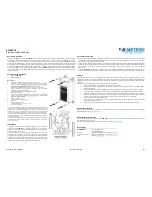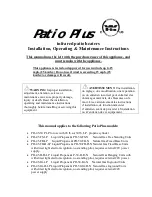
3.0
Installation
- GTD Installation, Operation, Maintenance and Parts Manual
3.0 Installation
Placement of infra-red tube heaters is influenced by many factors. Aside from safety factors,
considerations such as the number of elbows that are allowed, maximum vent lengths, ducting of
combustion air and combining vents are a few examples. It is critical that all guidelines and instuctions are
followed.
To ensure a properly designed heating system, a heating layout should be developed for the correct
placement of the burner control box, radiant tubing, venting and combustion air intake ducts. Inspect and
evaluate the mounting conditions, vent locations, gas supply and electrical wiring. Refer to the chart below
for the recommended distances for the model being installed.
3.1 Design Considerations and Prechecks
NOTE:
The effective infrared surface temperature
of a person or object may be diminished with wind
above 8 km/h. The use of adequate wind barrier(s)
may be required.
NOTE:
When heated, materials high in
hydrocarbons (solvents, paint thinner, mineral
spirits, formaldehydes, etc.) can evaporate. This
may result in odors or fumes being emitted into the
environment. To correct this problem, clean the
area and/or introduce additional ventilation.
Heaters installed and serviced in accordance with
the installation manual do not emit odors into the
environment. See notice on page 28 for additional
information.
• Has the building’s heat loss been evaluated?
• Does the design meet the needs of the space?
• Have all clearance to combustible situations been
observed?
• Have recommended mounting heights been
observed?
• Is the supply (burner) end of the heater located
where more heat is required?
• Is it best to offset the heaters and/or rotate the
reflectors towards the heat zone?
• Are protective guards, side shields, ‘U’ or ‘L’
reflector covers needed?
• Does the heater require outside fresh air for
combustion?
• Is the enviroment harsh or contaminated
(requiring outside air for combustion)?
• Are chemicals or vapor a concern (requiring
outside air for combustion)?
When designing an infrared radiant heating system, consider the following:
8









































